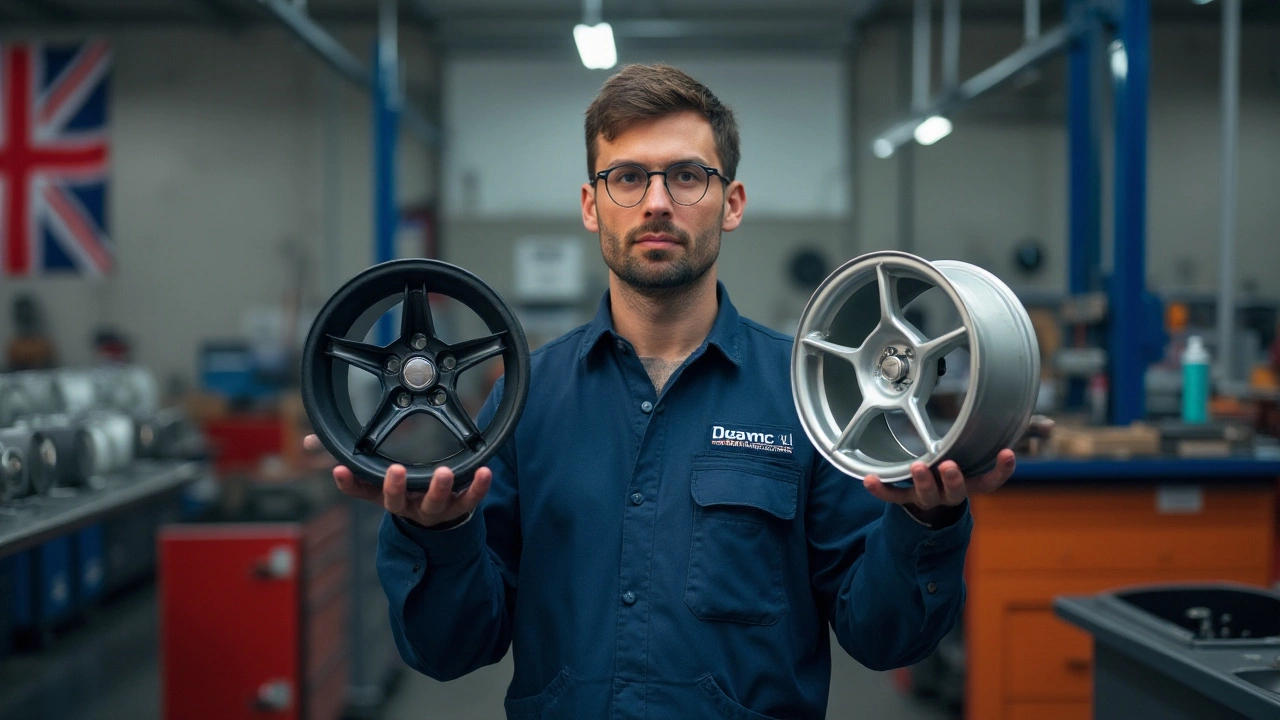When it comes to choosing the right wheels for your vehicle, the decision often boils down to a choice between standard wheels and alloy wheels. Each type offers distinct features, and understanding these differences is crucial for making the best decision for your driving needs.
Standard wheels, typically made of steel, are often favored for their strength and cost-effectiveness. On the other hand, alloy wheels, usually crafted from a blend of metals like aluminum, shine in performance and aesthetic departments. Car enthusiasts often debate over which wheel type reigns supreme, but it all boils down to individual preferences and requirements.
Let's delve into the characteristics of both standard and alloy wheels to figure out which might be the best fit for your vehicle. You might find that your choice could significantly influence your driving experience.
Material Composition
Understanding the material composition of wheels is fundamental to grasping their performance and functionality. Standard wheels are traditionally made from steel, a robust and inexpensive material known for its resilience. Steel wheels are typically created by stamping pieces of metal, which are then welded together. This method results in a wheel that can withstand significant loads and the daily wear and tear that vehicles encounter. Due to this toughness, steel wheels have long been the go-to choice for many car manufacturers, particularly for budget models or vehicles intended for rugged use.
On the contrary, alloy wheels are usually made from a composite of metals, with aluminum being the primary component. Aluminum alloys provide the perfect balance between strength and lightness. The casting process used in making alloy wheels allows for more intricate designs and gives manufacturers the flexibility to optimize wheel performance and style. One interesting facet of alloy wheels is their lower unsprung weight, which refers to the weight of components not supported by the vehicle's suspension. This aspect is crucial because it contributes to improved handling, acceleration, and braking, making alloy wheels highly desirable among car enthusiasts.
The variations in materials also manifest in durability and flexibility. While steel wheels are incredibly durable, making them resistant to cracks and bends—qualities appreciated in harsh driving conditions—their weight can negatively impact fuel economy. Alloy wheels, however, although lighter, are usually less forgiving when it comes to withstanding impacts, such as hitting a pothole. This trade-off between weight and durability is a significant consideration for drivers when selecting their wheels, especially for those who frequently drive on rough terrains or in adverse conditions.
As noted by Motor Trend, "The innate lightweight nature of aluminum alloys not only saves fuel but also reduces the inertia of vehicles, ultimately enhancing their performance."In addition to structural differences, the material composition affects the aesthetic appeal of a wheel. Alloy wheels come with an extensive range of finishes and colors due to the flexible manufacturing processes they undergo, making them a favorite for those who prioritize style.
If we compare the manufacturing complexity, steel wheels typically undergo a more straightforward production process, which translates to lower costs. In contrast, the sophisticated casting and forging process used for alloy wheels justify their higher price tag. When choosing between the two, it's essential to weigh these factors based on personal needs and budget.
To wrap up this section on material composition, here’s a quick look at some facts: alloy wheels typically weigh 20-30% less than their steel counterparts. This reduction in weight can contribute to an improved fuel economy of up to 2-3%, a small but notable factor for those looking to save on fuel costs over time. So when selecting wheels, it’s worth considering these factors and how they align with your driving habits and vehicle requirements.

Performance and Handling
When you talk about the performance and handling of a vehicle, the type of wheel you choose can make a substantial difference. First and foremost, let's consider the essence of alloy wheels. These wheels are crafted from a mix of aluminum or magnesium with other elements. Such a composition makes them incredibly lighter than standard steel wheels. This reduction in unsprung weight allows for enhanced acceleration and braking. Drivers often notice improved agility on curvy roads, offering a more captivating driving experience. It's no surprise that many sports cars or high-performance vehicles come fitted with alloy wheels straight out of the factory. Their ability to heat up and cool down quickly thanks to the metal's heat conduction properties also helps in performance settings by keeping the tyres in optimal condition.
In stark contrast, standard steel wheels are heavier, which tends to offer a weighty feel that some drivers prefer for its solidity. While they might not provide the same performance benefits as alloy wheels, they do contribute to a more planted and stable ride, especially on rough roads where a heavier wheel can sometimes feel steadier. The increased weight, while sometimes seen as a drawback in terms of speed, can help improve grip in specific scenarios. For example, when driving on snow or ice, the extra weight might give better traction at lower speeds.
An insightful quote on wheel performance from renowned automotive expert Jeremy Clarkson says,
"A great set of wheels can transform the blandest of cars into something rather special."This sentiment resonates, especially when considering that drivers who focus on performance often look towards alloy wheels for the edge they provide. In addition, it's worth considering the aspect of fuel efficiency. The lighter nature of alloy wheels can help improve a vehicle's fuel economy because the engine doesn't have to work as hard to propel the car forward.
For those interested in numbers, a standard steel wheel can weigh around 5 to 6 kilograms more than its alloy counterpart. Over the course of a long drive, this seemingly minor difference in weight can add up to a noticeable disparity in how often you might need to fill up at the petrol station. Many car aficionados champion alloy wheels for this reason among others. Indeed, some studies have shown that a reduction in weight by 10kg can enhance fuel efficiency by about 5%. This kind of efficiency gain is especially attractive to those who keep an eye on both performance and sustainability.
Finally, handling characteristics can also be influenced by the wheel's ability to change direction. With reduced rotational mass, a car fitted with alloy wheels can often achieve quicker and more responsive steering input. Any encounter with tight corners or sudden maneuvers comes with more precision and control. In closing, whether you prioritize the aesthetically appealing and nimble benefits of alloy wheels or favor the robust reliability and stability of steel wheels, understanding your needs and preferences goes a long way in making the right choice.

Cost and Maintenance
Choosing between standard wheels and alloy wheels isn't just about performance and aesthetics; cost and maintenance play a vital role too. Traditionally, standard wheels made from steel are more affordable, making them a common choice for everyday car owners. The steel used is readily available and easy to manufacture, keeping production costs low. This affordability comes with a trade-off, though − steel wheels are usually heavier, which might affect fuel efficiency over time. However, their robustness is hard to beat, providing a sense of peace for those driving on uneven terrains.
When you delve into the realm of alloy wheels, the initial costs can be higher. These wheels are crafted through more intricate processes that involve melting and mixing metals like aluminum, and sometimes magnesium. The resulting wheel is not only lighter, promoting better handling and fuel economy, but it also allows for more intricate designs, appealing to car enthusiasts. According to a study featured in Automotive News, vehicles fitted with alloy wheels tend to show an improved rate in fuel efficiency by approximately 2-3%. This means if you plan on longer commutes or spirited driving adventures, the initial investment could pay off in fuel savings alone.
Maintenance is another critical factor. Alloy wheels require a bit more attention than their steel counterparts. Though they prove more resistant to rust, they can be prone to oxidation and cosmetic damage like scratches or curb rash. Regular cleaning with pH-balanced soaps and checking for any damages is often advised. If you've ever parked swiftly and heard that dreaded scrape, a professional repair might be necessary to retain their appearance and functionality. Meanwhile, steel wheels might not demand such vigilant maintenance, but keeping them clean and free from rust is crucial too, especially if you live in areas where roads are salted in winter.
Moreover, insurance costs can be influenced by the type of wheels your vehicle sports. As alloy wheels are more expensive to manufacture and repair, they might lead to slightly increased insurance premiums. On the flip side, they could also enhance the resale value of your car, an aspect worth considering if you plan to sell or trade your vehicle in the future. In some cases, upgrading to alloy wheels offers a marginal increase in resale price, potentially offsetting the initial expenditure. Each driver's priorities will differ, but weighing these factors can help in making an informed decision.

Aesthetic Appeal
Diving into the world of car wheels, the allure of alloy wheels often captivates with their sheer beauty and elegance. This appeal is more than skin deep; it's an amalgamation of design intricacy and material science. Unlike standard wheels that often cater to utility, alloy wheels offer a canvas for artistic expression. Manufacturers craft these wheels in a myriad of styles—from sleek and minimalistic to bold and assertive designs—catering to diverse tastes and the quest for personalization. Alloy wheels are a trendsetter in automotive fashion, often showcased in glossy automotive magazines and premium car advertisements, symbolizing sophistication and affluence. The ability to make a statement without uttering a word is what draws many enthusiasts to these metallic masterpieces.
Remarkably, alloy wheels aren't merely about looking good parked in a garage or rolling on a highway. They accentuate the curves of a vehicle, harmonizing with its design language, elevating the visual experience manifold. Their aesthetic diversity is matched by the options in finishes: chrome, polished, matte, powder-coated—the possibilities seem endless. Specific finishes like matte black can add a stealthy and aggressive demeanor, whilst polished chrome exudes luxury and flamboyance. A notable fact here is that many high-end sport vehicles are customized with alloy wheels to not only enhance performance but also to brandish their racing pedigree. An interesting comment I came across by a well-known automotive designer noted, "
Alloy wheels are the shoes of a vehicle; they can make or break the entire look." This goes to show the profound impact these wheels have on a vehicle's visual appeal.
Alongside their distinguished looks, alloy wheels stand resilient against the ravages of time and weather. Where steel wheels might show signs of corrosion or rusting over time, especially in harsh climates, the corrosion-resistant nature of alloys keeps them shining year-round with minimal upkeep. This presents not just a functional advantage, but also ensures the integrity of their aesthetics over time. Enthusiasts often find themselves admiring the contours and light-catching facets of these wheels, which are designed to turn heads on both sunny days and moon-lit nights. Often alloy wheels come with intricately carved spokes that perform the dual task of aesthetics and function, allowing for improved heat dissipation from brakes. These practical designs marry the functional benefits of light weight with an aesthetic that captivates.
It's essential to remember that the aesthetic enhancement provided by alloy wheels often speaks to a broader cultural appreciation for craftsmanship and detail. In many ways, these wheels symbolize the meeting point of functionality and art. They are not only a testament to technological achievement in metallurgy but also embody an artistic vision that captures the imagination of onlookers. This unique combination is, perhaps, why alloy wheels remain an enduring choice for those who place aesthetics on an equal footing with performance. Touring the world of alloy wheels is an exciting journey into the visual language of automobiles, where each set tells its own story.




